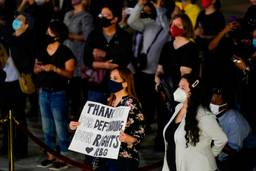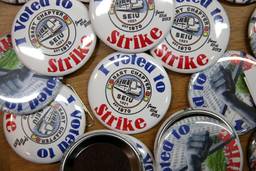
On July 17, a tentative deal was reached between a coalition of eight unions representing New York’s Long Island Rail Road (LIRR) Workers and the Metropolitan Transit Authority (MTA) after Governor Andrew Cuomo intervened in a bid to avoid a strike. The new deal means raises for the unions over six and a half years and, for the first time in its history, LIRR workers will contribute a percentage of their pay toward health insurance.
“I’m relieved, “ union representative Dean Devita said of the compromise. “I’m thrilled a strike was avoided.” LIRR employees had been working without a contract for four years.
But while the media and advocates alike are billing Cuomo’s actions as pro-labor, the governor’s history may be telling a different story.
On Monday, it seemed as if talks had broken down, but after Cuomo directed the two sides to meet again on Wednesday, sizable progress seems to have been made.
Cuomo’s mediation surprised observers who had seen the governor shrug off the threat of a LIRR strike only a week before, including union members who believed the strike was an inevitability.
As the members of the MTA board are all Cuomo appointees, the governor’s intervention shouldn’t come as much of a surprise. Still, the image of Cuomo sweeping in to help commuters, and distinguishes him from his father, former Governor Mario Cuomo, who thrust himself into the middle of negotiations between the LIRR and the MTA, in 1994. The elder Cuomo even skipped the New York Rangers’ Stanley Cup parade, in favor of working on averting the ‘94 strike. At the time, Cuomo was involved in a tenacious fight for reelection and the prospect of losing suburban votes was a grave concern. In the end, LIRR went on a short strike after a panel of mediators set up by President Clinton failed to generate any results. Not long after, George Pataki narrowly beat out Cuomo to become Governor. In contrast, the younger Cuomo will now run for reelection on a platform boosted by a major — and tangible — success; he’s saved the day.
“Governor Cuomo showed great leadership,” Devita told me. These sentiments were echoed by Peter Salins, a political science professor at Stony Brook University, who told the Associated Press, “He made the strike — which would have been a nightmare — go away … In the short-term it’s clearly a win for the governor and for Long Island commuters.”
However, viewing Cuomo as a sort of savior obscures the wider narrative. Going into negotiations, some union members felt that the LIRR’s leverage had been dealt a blow by the details of the April deal reached between the TWU (Transport Workers Union) and the MTA. While many viewed the new contract as a victory for the TWU, some were concerned that the details could be used against the LIRR workers. That deal contained two notable concessions: it will now take five years for workers to generate top pay, as opposed to the previous 3 years,. They will also have to pay more toward health care costs. Additionally, the raises that the workers obtained start at 1 percent for first two years. Cuomo made the announcement, regarding that contract, from his office with, MTA chairman, Thomas Prendergast and, Local 100 of the Transport Workers Union President, John Samuelsen by his side.
The LIRR is different than other state unions, in that it falls under federal regulation laws, and as the workers had been without a contract since 2010, the Obama administration set up a panel to mediate the dispute. The disagreements that led up to the formation of the panel stemmed partially from the culture that Cuomo had developed; an emphasis on business interests and a vow to take on labor unions, which the New York Times referred to as a, “presidential-style permanent political campaign.” The anti-labor sentiment emboldened the MTA to stand up to the unions. “In reality, the MTA blew it early on in negotiations by offering a set of insulting and illogical demands: a three-year wage freeze followed by two 2 percent raises,” The New York Daily News transit reporter, Pete Donohue said. “That mirrored Cuomo’s stance toward a couple of upstate unions that have no historical relevance to transit union contracts or the cost of living downstate.” In other words, Cuomo provided the precedent for the MTA’s rejection.
The neutral Presidential Emergency Board issued their findings in February and sided with the union, recommending a raise rate which amounted to about 16 percent over six years. The MTA claimed such a deal would break their budget and later identified Cuomo’s TWU deal as justification for its failure to act on the panel’s findings. The MTA’s stance was foreshadowed in a New York Daily News piece that posited: “Cuomo has proven that Bloomberg’s position [to attack public unions] was the right one — and exactly what de Blasio should follow.” These moves have all had the effect of depleting solidarity between transit workers, which is especially troubling when one considers that the MTA has historically paid the primarily-white LIRR workers more than NYC transit workers, many of whom are people of color.
When the TWU called on Cuomo for assistance with their contract, Samuelsen cited his ability to accelerate a compromise between New York City’s Consolidated Edison energy company and their workers in 2012. However, that deal also came with concessions: a new two-tier pension system and a newfound capacity for the lucrative company to fill 25 percent of their jobs with outside contracts. The fact that Samuelsen saw the Con Ed deal as a victory is telling, as many believed that a stronger fight from the union would have yielded more desirable results in their final contract.
While the public perception of Cuomo’s labor interventions may make him an appealing candidate for some, his interests remain firmly entrenched with New York’s elite. If he’s inherited any reputation as a great negotiator, it’s one that doesn’t stand up under closer inspection. One of the most intriguing components of the deal could be found in a New York Times article on the contract, “[LIRR workers’ new health care costs are] a significant change that could figure prominently in future negotiations throughout the region. Members of New York City’s municipal unions, for instance, generally do not pay for health care.” Yet.







